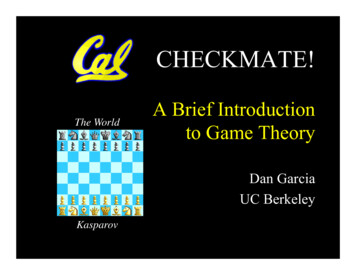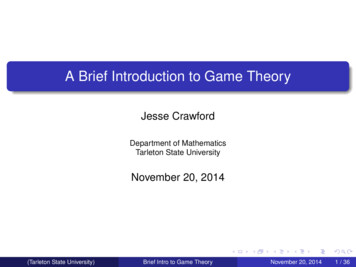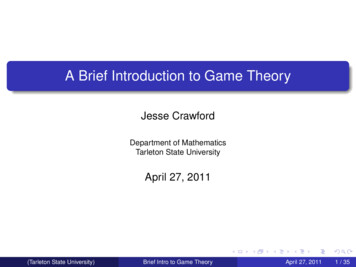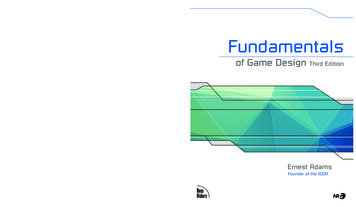
Transcription
CHECKMATE!The WorldA Brief Introductionto Game TheoryDan GarciaUC BerkeleyKasparov
Welcome! Introduction Topic motivation, goals Talk overview Combinatorial game theory basics w/examples“Computational” game theoryAnalysis of some simple gamesResearch highlightsA Brief Introduction to Game Theory2/39
Game Theory:Economic or Combinatorial? Economic Combinatorial von Neumann andMorgenstern’s 1944Theory of Games andEconomic Behavior Matrix games Prisoner’s dilemma Incomplete info,simultaneous moves Goal: Maximize payoff Sprague and Grundy’s1939 Mathematics andGames Board (table) games Nim, Domineering Complete info,alternating moves Goal: Last moveA Brief Introduction to Game Theory3/39
Why study games? Systems design Decomposition intoparts with limitedinteractions Complexity Theory Management Determine area tofocus energy /resources Artificial Intelligencetesting grounds “People want tounderstand the thingsthat people like to do,and people like to playgames”–Berlekamp & WolfeA Brief Introduction to Game Theory4/39
Combinatorial Game TheoryHistory Early Play Egyptian wall paintingof Senat (c. 3000 BC) Theory C. L. Bouton’s analysisof Nim [1902] Sprague [1936] andGrundy [1939] Impartialgames and Nim Knuth Surreal Numbers[1974] Conway On Numbers andGames [1976] Prof. Elwyn Berlekamp(UCB), Conway, & GuyWinning Ways [1982]A Brief Introduction to Game Theory5/39
What is a combinatorial game? Two players (Left & Right) move alternately No chance, such as dice or shuffled cards Both players have perfect information No hidden information, as in Stratego & Magic The game is finite – it must eventually end There are no draws or ties Normal Play: Last to move wins!A Brief Introduction to Game Theory6/39
What games are out, what are in? Out All card games All dice games In Nim, Domineering, Dots-and-Boxes, Go, etc. In, but not normal play Chess, Checkers, Othello, Tic-Tac-Toe, etc.A Brief Introduction to Game Theory7/39
Combinatorial Game TheoryThe Big Picture Whose turn is not part of the game SUMS of games You play games G1 G2 G3 You decide which game is most importantYou want the last move (in normal play)Analogy: Eating with a friend, want the last biteA Brief Introduction to Game Theory8/39
Classification of Games Impartial Partisan Same moves availableto each player The two players havedifferent options Example: Nim Example: DomineeringA Brief Introduction to Game Theory9/39
Nim : The Impartial Game pt. I Rules: Several heaps of beans On your turn, select a heap, andremove any positive number ofbeans from it, maybe all Goal Take the last bean2357 Example w/4 piles: (2,3,5,7)A Brief Introduction to Game Theory10/39
Nim: The Impartial Game pt. II Dan plays room in (2,3,5,7) Nim Pair up, play (2,3,5,7) Query:23 First player win or lose? Perfect strategy? Feedback, theories? Every impartial game is equivalentto a (bogus) Nim heapA Brief Introduction to Game Theory5711/39
Nim: The Impartial Game pt. III Winning or losing? Binary rep. of heaps Nim Sum XOR Zero Losing, 2nd P win Winning move? Find MSB in Nim Sum Find heap w/1 in that place Invert all heap’s bits fromsum to make sum zero01102113101511171100A Brief Introduction to Game Theory12/39
Domineering: A partisan game Rules (on your turn): Place a domino on the board Left places them North-South Right places them East-West GoalLeft (bLue)Right (Red) Place the last domino Example game Query: Who wins here?A Brief Introduction to Game Theory13/39
Domineering: A partisan game Key concepts Left (bLue)Right (Red) By moving correctly, youguarantee yourself future moves. For many positions, you want tomove, since you can stealmoves. This is a “hot” game. This game decomposes into noninteracting parts, which weseparately analyze and bringresults together.A Brief Introduction to Game Theory14/39
What do we want to know abouta particular game? What is the value of the game? Who is ahead and by how much? How big is the next move? Does it matter who goes first? What is a winning / drawing strategy? To know a game’s value and winning strategyis to have solved the game Can we easily summarize strategy?A Brief Introduction to Game Theory15/39
Combinatorial Game TheoryThe Basics I - Game definition A game, G, between two players, Left andRight, is defined as a pair of sets of games: G {GL GR } GL is the typical Left option (i.e., a positionLeft can move to), similarly for Right. GL need not have a unique value Thus if G {a, b, c, d, e, f, }, GL meansa or b or c or and GR means d or e or f or .A Brief Introduction to Game Theory16/39
Combinatorial Game TheoryThe Basics II - Examples: 0 The simplest game, the Endgame, born day 0 Neither player has a move, the game is over{ Ø Ø } { }, we denote by 0 (a number!)Example of P, previous/second-player win, losingExamples from games we’ve seen:NimDomineeringA Brief Introduction to Game TheoryGame Tree17/39
Combinatorial Game TheoryThe Basics II - Examples: * The next simplest game, * (“Star”), born day 1 First player to move wins{ 0 0 } *, this game is not a number, it’s fuzzy!Example of N, a next/first-player win, winningExamples from games we’ve seen:NimDomineeringGame Tree1A Brief Introduction to Game Theory18/39
Combinatorial Game TheoryThe Basics II - Examples: 1 Another simple game, 1, born day 1 Left wins no matter who starts{ 0 } 1, this game is a numberCalled a Left win. Partisan games only.Examples from games we’ve seen:NimDomineeringA Brief Introduction to Game TheoryGame Tree19/39
Combinatorial Game TheoryThe Basics II - Examples: –1 Similarly, a game, –1, born day 1 Right wins no matter who starts{ 0 } –1, this game is a number.Called a Right win. Partisan games only.Examples from games we’ve seen:NimDomineeringA Brief Introduction to Game TheoryGame Tree20/39
Combinatorial Game TheoryThe Basics II - Examples Calculate value forDomineering game G:G { } { 1 – 1 } 1 this is a fuzzy hot value,confused with 0. 1st player wins.LeftRight Calculate value forDomineering game G:G {, {–1 , }0 1} { 0 1 } { .5 } this is a cold fractional value.Left wins regardless who starts.A Brief Introduction to Game Theory21/39
Combinatorial Game TheoryThe Basics III - Outcome classes With normal play, everygame belongs to one offour outcome classes(compared to 0): Zero ( )Negative ( )Positive ( )Fuzzy ( ),incomparable,confusedLeftstartsRight startsand L haswinningstrategyand R haswinningstrategyZEROG 02nd winsand L haswinningstrategyPOSITIVEG 0L winsA Brief Introduction to Game Theoryand R haswinningstrategyNEGATIVEG 0R winsFUZZYG 01st wins22/39
Combinatorial Game TheoryThe Basics IV - Negatives & Sums Negative of a game: definition – G {– GR – GL}Similar to switching places with your opponentImpartial games are their own neg., so – G GExamples from games we’ve seen:NimDomineering1122–GGGRotate90 Game TreeFlip–GA Brief Introduction to Game TheoryG–G23/39
Combinatorial Game TheoryThe Basics IV - Negatives & Sums Sums of games: definition G H {GL H, G HL GR H, G HR} The player whose turn it is selects onecomponent and makes a move in it. Examples from games we’ve seen:G H { GL H, G H1L , G H2L GR H, G HR } {, , A Brief Introduction to Game Theory , }24/39
Combinatorial Game TheoryThe Basics IV - Negatives & Sums G 0 G The Endgame doesn’t change a game’s value G (– G) 0 “ 0” means is a zero game, 2nd player can win Examples: 1 (–1) 0 and * * 0Nim1 *1 *Domineering1–1**A Brief Introduction to Game TheoryGame Tree–11025/39
Combinatorial Game TheoryThe Basics IV - Negatives & Sums G H If the game G (–H) 0, i.e., a 2nd player win Examples from games we’ve seen:Is G H ?Is G H ?Play G (–H) andsee if 2nd player winPlay G (–H) andsee if 2nd player winLeftYes!RightA Brief Introduction to Game TheoryNo.26/39
Combinatorial Game TheoryThe Basics IV - Negatives & Sums G H (Games form a partially ordered set!) If Left can win the sum G (–H) going 2nd Examples from games we’ve seen:Is G H ?Is G H ?Play G (–H) and see ifLeft wins going 2ndPlay G (–H) and see ifLeft wins going 2ndLeftYes!RightA Brief Introduction to Game TheoryNo.27/39
Combinatorial Game TheoryThe Basics IV - Negatives & Sums G H (G is incomparable with H) If G (–H) is with 0, i.e., a 1st player win Examples from games we’ve seen:Is G H ?Is G H ?Play G (–H) andsee if 1st player winPlay G (–H) andsee if 1st player winLeftNo.RightA Brief Introduction to Game TheoryYES!28/39
Combinatorial Game TheoryThe Basics IV - Values of games What is the value of a fuzzy game? It’s neither 0, 0 nor 0, but confused with 0 Its place on the number scale is indeterminate Often represented as a “cloud” Let’s tie the theory all together!-2-1.5-1-.50.5A Brief Introduction to Game Theory11.5229/39
Combinatorial Game TheoryThe Basics V - Final thoughts There’s much more! More values Up, Down, Tiny, etc. Simplicity, Mex ruleDominating optionsReversible movesNumber avoidanceTemperatures Normal form games Last to move wins, no tiesWhose turn not in gameRich mathematicsKey: Sums of gamesMany (most?) games arenot normal form! What do we do then?A Brief Introduction to Game Theory30/39
“Computational” Game Theory(for non-normal play games) Large games Can theorize strategies, build AI systems to play Can study endgames, smaller version of original Examples: Quick Chess, 9x9 Go, 6x6 Checkers, etc. Small-to-medium games Can have computer solve and teach us strategy GAMESMAN does exactly thisA Brief Introduction to Game Theory31/39
Computational Game Theory Simplify games / value Store turn in position Each position is (forplayer whose turn it is) Winning ( losing child) Losing (All childrenwinning) Tieing (! losing child,but tieing child) Drawing (can’t force awin or be forced to lose)W.WWWL.LT.WWWA Brief Introduction to Game TheoryWWWDTWD.WWW32/39W
GAMESMANAnalysis: TacTix, or 2-D Nim Rules (on your turn): Take as many pieces asyou want from anycontiguous row / column Goal Take the last piece Query Column Nim heap? Zero shapesA Brief Introduction to Game Theory33/39
GAMESMANAnalysis: Tic-Tac-Toe Rules (on your turn): Place your X or O in anempty slot Goal Get 3-in-a-row first inany row/column/diag. Misére is trickyA Brief Introduction to Game Theory34/39
GAMESMANTic-Tac-Toe Visualization Visualization of values Example with Misére Outer rim is position Next levels are valuesof moves to that position Recursive imageLose Legend:TieWinA Brief Introduction to Game Theory35/39
Exciting Game Theory Researchat Berkeley Combinatorial Game Theory Workshop MSRI July 24-28th, 2000 1994 Workshop book: Games of No Chance Prof. Elwyn Berlekamp Dots & Boxes, Go endgames Economist’s View of Combinatorial GamesA Brief Introduction to Game Theory36/39
Exciting Game Theory ResearchChess Kasparov vs. World, Deep Blue II Endgames, tablebases Stiller, Nalimov Combinatorial GT applied Values found [Elkies, 1996] SETI@Home parallelpower to build database? Historical analysis.White to move, wins in move 243A Brief Introduction to Game TheorywithRd7xNe737/39
Exciting Game Theory ResearchSolving games 4x4x4 Tic-Tac-Toe [Patashnik, 1980]Connect-4 [Allen, 1989; Allis, 1988]Go-Moku [Allis et al., 1993]Nine Men’s Morris [Gasser, 1996] One of oldest games – boards found c. 1400 BC Checkers almost solved [Schaeffer, 1996]A Brief Introduction to Game Theory38/39
Summary Combinatorial game theory, learned games Computational game theory, GAMESMAN Reviewed research highlightsA Brief Introduction to Game Theory39/39
A Brief Introduction to Game Theory 30/39 Combinatorial Game Theory The Basics V - Final thoughts There’s much more! More values Up, Down, Tiny, etc. Simplicity, Mex rule Dominating options Reversible










